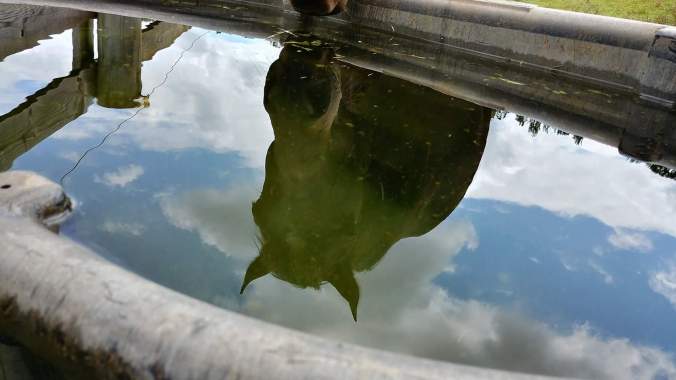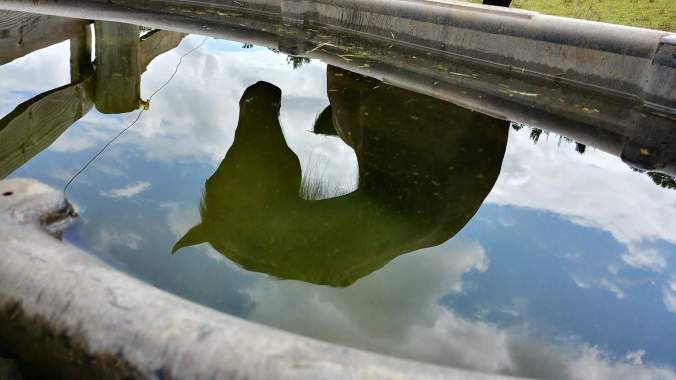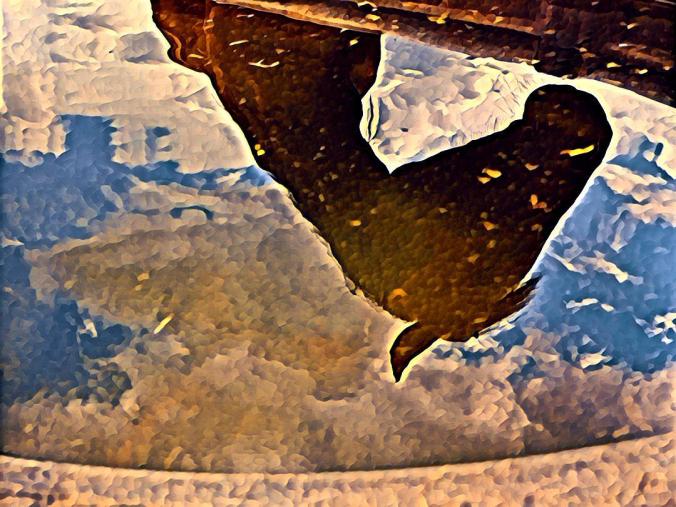
About four weeks ago while watering the horses at feeding time, I dragged the hose to the end of its length to reach far enough to water Guinness. I stood there for about ten minutes, spraying him down. After a while it dawned on me that I didn’t need to wait for it to soak down to his roots, and if in fact it soaked all the way down to him that was quite a bit farther than it needed to go to water the grass seed I had just finished spreading on his grave.
We now have more horses below ground (five) on this property than above (three). Each of them has a grave site planted and tended slightly different from all the others. Three of them are outside of the pastures, and one is in a fenced area within a pasture. All of them are planted in flowers of different kinds, and each has a tree that volunteered on their grave, or somewhere else on our property that we transplanted. Those trees range in height from Cookie’s five foot maple (4 years ago) to Wy’s twenty-plus foot oak (18 years ago).

Guinness was a horse’s horse, and he was Finn’s other half. We decided we wanted them to stay together, and for Guinness to be part of the horse landscape. So for the first time, we just covered a grave with grass seed and chopped hay to give it a chance to stay in one place and grow. For several days, the biggest challenge for the seed was that Finn kept rolling on Guinness. I don’t know if he liked the feel of the chopped hay, the fact that we were watering it so it was a nice cool spot, or if he just wanted to be close to his buddy. We will plant Guinness a shade tree in the fall, outside the fence so Finn can’t eat it.
Twice a day in the summer heat, we water the horses. They have hundred gallon troughs, but we don’t fill them all the way because that way we can keep adding a little water to keep it cool for them. We also offer to hose them off, so when they want, they get the sweat showered off. After doing the living horses, I dragged the hose to Guinness. We were in a bit of a drought – hard to believe, now that we’ve been getting flooded out for the past two weeks – and Guinness is buried at the top of the hill in the back field he shared (and still does) with Finn. That spot has the best view on the farm, but it is a lot of hoses away from the nearest water source.

My family does not run to grave sites. My grandmother was cremated, and buried in a graveyard next to my grandfather who died long before I was born. But after that, all bets were off.
My father gave me custody of my mother’s ashes, with instructions to scatter them by the tree we planted for her on my property. I did that with some of her ashes, but before she died she told me that she would be sad if she never got back to New Hampshire, or to Rehoboth beach. She didn’t, so I got her both places posthumously. I took some of her ashes to Rehoboth, and scattered them in the ocean. My aunt buried some of her ashes in her garden in Virginia, and sent some to my uncle in New Hampshire, where he paddled them out to the middle of Squam Lake and scattered them in her favorite childhood place. It was only much later that my father remembered she had told him she wanted her ashes spread in Rock Creek Park, though as her best friend recalled it, what she actually said was “Fling ’em off the Calvert Street bridge,” which seems more likely.
It was my father’s ashes that we scattered in Rock Creek Park, in the end, in the creek itself. There’s something vaguely furtive about scattering ashes in public places, be it the ocean or Rock Creek, but probably no one would in fact arrest you for it. Still, it’s hard to be solemn and ceremonial while looking over your shoulder as if you’re handing off the money to the drug dealer and hoping no one notices.
My aunt was scattered in a few places, too. The day of her memorial service we scattered some of her ashes in her beloved Blue Ridge mountains, in one of the prettiest spots I know. I believe some went up to New England, and some were scattered in a memorial garden at a wildlife sanctuary in Virginia – a certain blessing to the animals there.
I wouldn’t want anyone stuck in a graveyard, and I certainly don’t want to end up in one myself, but I’m starting to understand their purpose. We have planted trees on our property in memory of people and animals who have died since we moved here. We celebrate our own version of Dia de los Muertos each November. Sometimes we clean up the memorial (human) and grave (animal) sites, and plant flowers, and sometimes we just light luminaria for each of them, but it’s a ceremony we hold dear.
Standing over Guinness’ grave twice each day, watering the grass seed and letting my mind wander, was a meditative exercise for me. It was also a transition time. I know there are sudden deaths, but with most of my animals and all of my relatives, dying has been a process, with a lot of activity and attention needed over a fairly long span of time. With Guinness, for example, he was sick for about six weeks. We tried everything we could think of to diagnose and treat him. Like any sick room, our feed shed was full of supplements and medicines when he died. I checked him, treated him, and tried to get him to eat four to six times a day, all the while watching him fade away. Throwing away the useless prescriptions is something I’ve done a few too many times now, but I’m sure I will do it again. Watering his grave was a way for me to keep tending to him while also gradually letting him go.

I am moved by your whole blog. And then that last line! This is the wisdom that grief offers, and you so articulately share with us. Thank you. xo
LikeLiked by 1 person
Loved reading this blog this morning. When we have horses and other animals as part of our family, it seems that death is always near and the losses are many, but so is the joy. I will be thinking of your words and of Guiness and the others there when I water my above ground horses today.
LikeLiked by 1 person
“Watering his grave was a way for me to keep tending to him while also gradually letting him go”. Just lovely. I’m fascinated to learn about what it’s like to have and tend to real horses (my Breyer collection requires only dusting). I love the idea of you having enough land to bury them. I grew up burying some of our pets on our almost one acre property, and there is a certain peace to it.
LikeLiked by 1 person